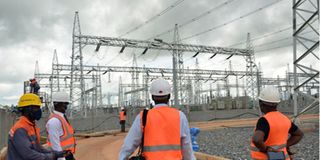Govt seeks alternative energy sources to hit electricity target

UETCL officials inspect the Karuma Hydropower Dam switch yard recently. The transmission company has said it is ready to evacuate power from the dam to the consumers. PHOTO | TOBBIAS JOLLY OWINY
Uganda Electricity Generation Company Limited (UEGCL) is exploring alternative sources of energy to generate 40,000MW electricity target set by the National Development Plan Vision 2040.
While closing a week long safe, reliable and generation fleet management training for its senior employees, Eng Harisson Mutikanga the UEGCL managing director, said they are exploring alternative energy sources away from hydro power to raise 40,000MW, projected to be needed by 2040.
“There is a lot of economic growth happening in the country. We have a lot of manufacturing, we are exporting power to neighbors, we shall have improved railway systems and every Ugandan should have electricity,” he said, noting that nuclear energy, which President Museveni talked about recently, solar and geo thermal are some of the alternatives sources which are expected to close the deficit of 38,000MW.
Government expects to add 600 MW on the current 1,300 MW supply when it launches Karuma Hydro power plant.
Mr Okasai Opolot, the Energy state minister, noted that it was important for UEGCL to collect all data on generated energy including that from private solar panels. Electricity consumption, he said is higher but hydroelectricity only contributes 17 percent while the rest is coming from other energy sources.
“We should start gathering data from all the mini grids so that we can compute and know how much we are generating. We are only capturing data from what we generate from hydroelectricity but the new law will bring together all energy generated whether it is from a house lit using solar,” he said.
In the 2019/20 House Hold Survey, Uganda National Bureau of Statistics, indicated that solar energy consumption had grown to about 36 percent overtaking hydroelectricity connections, which during the period had dropped from 22 percent to about 19 percent.
Mr Opolot noted that it was important that solar users are captured to understand energy supply both in rural and urban areas.
Asked what happened to the free electricity connection policy government initiated, he said they do not have the money yet but individuals who feel they can connect electricity to their premises on their own, can go ahead because that does not violate the policy.




